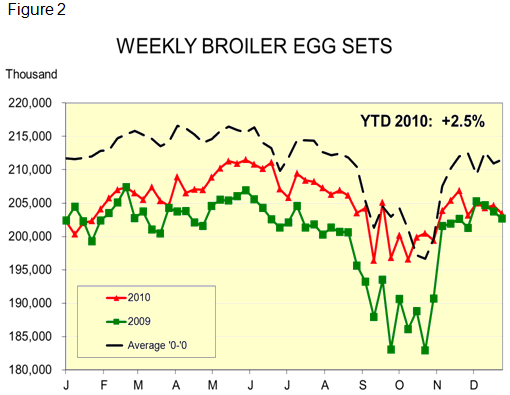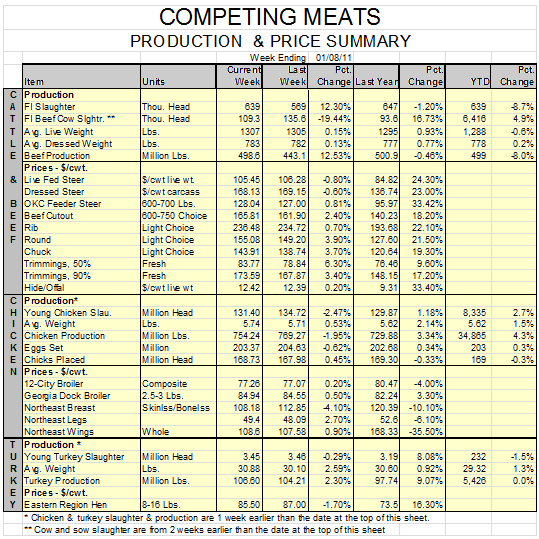



Market Preview: Chicken, Lean Hog Futures
US - In this week of National Hog Farmer's Market Preview, Steve Meyer discusses the importance of keeping an eye on chicken and lean hog futures.Aside from the always-present, yet unlikely, possibility of a catastrophic occurrence, such as foot-and-mouth disease or some unforeseen food safety issue with pork, my biggest concern for livestock and poultry markets in 2011 has for some time been whether the chicken companies would produce us all right out of a good year.
These outfits had understandably moved back into expansion mode in early 2010, as feed costs fell and the restaurant trade, though still far from good, picked up a bit. Their difficulties with exports to Russia took some luster off of 2010, but it was good enough to start the broiler breeder flock growing again and push chicken output up by 2.5 per cent for the 52 weeks that ended 1 January.
But the road to recovery and expansion became rocky for the broiler companies just like it did for pork producers when grain prices began to climb last summer. Figure 1, which comes courtesy of Karl Skold of Westside Economics in Omaha, shows the steady decline of broiler margins from mid-June onward. They became negative in mid-November.

My concern, of course, was that broiler companies may either see these negative returns as temporary or may see them as just the price to pay for market share. The former is obviously not the case, at least for this grain marketing year. The latter sounds shaky as well, but it is the mindset that dominated broiler companies for many years when broiler demand and consumption were growing steadily. A “damn the torpedoes” approach this year could be bloody indeed for the broiler sector, but would also drive broiler prices lower and very likely put a lid on the level of prices that might be achieved this year by pork and beef products.
Add in the fact that two of the giants of the broiler sector, Tyson Foods and Pilgrim’s Pride, have the necessary financial resources to force the issue on market share and you have the makings for a potential disaster. Tyson’s resources were generated internally by one of its best years ever. Pilgrim’s resources come from its now-parent company, JBS USA and its ties to JBS in Brazil and the cozy relationship it has with Brazil’s national bank.
It appears, though, that more conservative – and I would say logical – thinking is prevailing. Figures 2 and 3 show that egg sets and chick placements slowed sharply late in 2010. Egg sets ended the year 2.5 per cent larger than in 2009, but since 1 November, they were only 1.1 per cent higher than last year and 2 per cent lower than the five-year average, which indicates a normal seasonal surge in sets.


Changes in placements, of course, lag those of egg sets by three weeks, so we have not seen as dramatic a change in level there yet. But it is clear that placements have moved closer to year-ago levels after running as much as 9.7 per cent higher than last year during October and November.
I think the only difference between the pork sector and the chicken sector is that pork producers did not get nearly as far down the positive-output-response road. Higher grain prices derailed our expansion before it even got started. Now, the prospect of breakeven cost levels above $80/cwt., carcass, this year will keep that expansion slow. Yes, some producers will replace sows and some empty units are being refilled. But those higher costs may put enough pressure on less efficient producers to offset much, if not most, of that expansion for at least the next quarter or two.
Bottom Line
The slowing of broiler expansion will be positive for markets in 2011. Live cattle futures are already record high, as they should be in my opinion, given the expected reduction in cattle numbers and beef production. Lean Hog (LH) futures are in rarified air with May through August above $90 and the charts showing no signs of topping yet!
Could we see $100 summer hogs? It cannot be ruled out and, given June futures were at $94.50 on Monday morning, it is getting more and more likely. I do not ascribe to these markets having much of a sense of detail, so when we get this close, I usually think we could add another $5 by accident and that would put us above $100.
That has happened once before when June 2009 LH futures briefly traded at $100 in June 2008. That was not a very useful occurrence given the low volumes and open interest in those distant contracts. But this one is a different story and perhaps should be used aggressively if the charts begin signaling a top.
If you feel a little reluctant to do so, just ask yourself: “How many hogs have you locked in at $90-plus in the past?”










